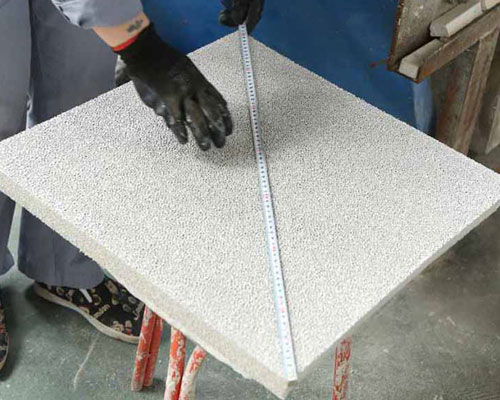The molten metal filter plate has an open-pored structure, which is characterized by having a plurality of interconnected voids, so that molten metal can pass through, to remove or minimize entrained solids from the final cast product, or to promote the melt and melt Impurity exchange between. Such filters may include solid filters, plates made of sintered ceramic aggregate or porous carbon plates, ceramic foam filter plates.
The ceramic foam filter has an open-cell structure, which is characterized in that a plurality of interconnected voids are surrounded by the mesh of the ceramic material. It has a low cost and can be used once. In addition, the filter can effectively filter molten metal, especially aluminum, and achieve a filtration efficiency with considerable flexibility at a low cost.
The first filter-type medium may be prepared to have a relatively coarse pore size of 10 to 20 PPI, which has an air permeability of 2500 to 8000×10 -7 cm 2, and the second filter medium includes a relatively fine filter, which has a hole number of 20 to 60 PPI and an air permeability of 400 to 2500×10 -7 cm 2. The metal flow rate through the filter ranges from 5 to 50 cubic inches per minute per square inch of filter. Naturally, the permeability and pore size of each filter-type medium can be varied to suit the specific material being filtered.
When the molten metal filter plate is designed as a disposable item, it is necessary to provide an effective means to seal the filter plate in its proper position in the holder, so as to be easy to assemble, disassemble, and clean. The holder or filter chamber itself is usually an integral part of the tank, dump tray or tundish, etc., and should be made of refractory material resistant to molten metal.
An elastic sealing device or a washer-type seal is used to seal the filter plate in place, and the seal or peripheral seal surrounds the filter plate at its inclined portion. The gasket seal ensures that there is no leakage in the installation and provides an effective separation medium, which is essential for easy disassembly.
In addition, since gaskets or sealing devices prevent metal from entering the sealing surface of the holder unit, their use greatly simplifies cleaning and effectively extends the life of the unit by eliminating the problem of metal corrosion. In addition, due to its elasticity, the gasket can provide sufficient friction to hold the filter body in place in the filter chamber without the need for other types of pressing devices. The elastic sealing device should deal with the specific molten metal that does not wet the metal, is resistant to chemical corrosion, and is fire-resistant enough to withstand higher operating temperatures.

